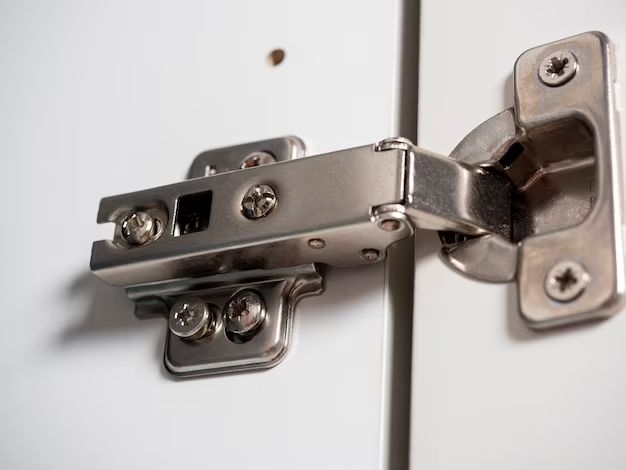Door hinges are an essential hardware component that allow doors to swing open and closed. Most residential and commercial doors are hung using three hinges, one near the top, middle, and bottom of the door. The hinge pins are the cylindrical parts inserted horizontally through the knuckle joints to connect the two hinge leaves together and allow them to pivot. Given how fundamental hinges are to the functionality of doors, an important question is whether door hinge pins follow standard sizing or if there are variances.
Page Contents
Common Door Hinge Sizes
There are several standard door hinge sizes used in residential and commercial applications:
| Hinge Type | Door Thickness | Hinge Pin Diameter |
|---|---|---|
| Standard Weight Full Mortise | 1-3/8″ door | 1/4″ |
| Heavy Weight Full Mortise | 1-3/4″ door | 5/16″ |
| Standard Weight Half Surface | 1-3/8″ door | 1/4″ |
| Heavy Weight Half Surface | 1-3/4″ door | 5/16″ |
As seen in the table, standard weight hinges for 1-3/8″ thick interior doors have 1/4″ diameter hinge pins, while heavy weight hinges for thicker 1-3/4″ exterior doors use larger 5/16″ pins. This correlates to the size and strength required for each hinge type.
Variances in Hinge Pins
While the standard pin diameters noted above are by far the most common, there can be some variance in certain situations:
– Antique or custom doors may have non-standard thicknesses, requiring unique hinge pins sizes not found in typical modern hinges.
– Solid metal hinges on heavy gates or doors sometimes require larger pin diameters up to 3/8″.
– Specialty hinges like rising butt hinges for lift-off doors may take smaller pins down to 1/8″ diameter.
– Some manufacturers offer hinge pins in metric diameters which differ slightly from the imperial fractional sizes.
– Lower quality hinges made overseas occasionally substitute pins that are slightly under the standard diameter specification.
– Old hinges can experience pin wear that reduces the diameter slightly over many years of use.
So while most residential and commercial hinges will follow the standard pin sizes, there are exceptions when antique, custom or specialty hardware is involved. Care should be taken to measure the pins and understand the required diameter if replacing hinges on non-standard thickness doors.
Hinge Pin Materials
In addition to diameter, hinge pins can be made from different materials including:
– Steel – The most common and economical material, providing good durability at low cost.
– Stainless steel – More expensive but highly rust and corrosion resistant for damp environments.
– Brass – Also corrosion resistant and can complement brass hinge leaves for aesthetics.
– Bronze – Provides a smooth pivoting motion and classic appearance. More costly.
| Material | Attributes |
|---|---|
| Steel | Inexpensive, strong, susceptible to rust |
| Stainless Steel | Corrosion resistant, durable, higher cost |
| Brass | Corrosion resistant, attractive with brass hinges, moderate cost |
| Bronze | Smooth pivoting, corrosion resistant, expensive |
The hinge pin material should be selected based on the environmental conditions and desired appearance. Stainless steel and brass hold up better in damp environments. Bronze offers the highest quality and smoothness. Steel pins provide reliable service at the lowest price point.
Replacing Hinge Pins
Over time, hinge pins can wear down or become difficult to move smoothly. This friction in the pivot joint makes the door harder to operate and can lead to looseness or sagging. Some signs that it’s time to replace hinge pins include:
– Door requires extra force to swing open or closed.
– Hinge squeaks or binds when moving.
– Visible wearing in the pin ends or knuckle holes.
– Pin can be moved in and out of the hinge, indicating worn fit.
– Rust flakes around pin ends due to moisture exposure.
To replace a steel or stainless steel hinge pin:
1. Remove the center pin using pliers or tapping it out.
2. Measure the old pin diameter with calipers.
3. Obtain a replacement pin of the same diameter and length.
4. Lightly lubricate the new pin and insert into hinge.
5. Check door swing; pin should move smoothly without play.
Brass and bronze pins can also be replaced but may need reaming or resizing the knuckle holes if wear is present. Take care to get a tight, smooth fit when installing new high quality pins.
Conclusion
While most standard residential and commercial hinges utilize 1/4″ or 5/16″ diameter pins corresponding to door thickness, many variables can alter this. Custom doors, specialty hinges, metric sizes, and wear over time lead to deviations from the norm. When undertaking installations or replacements, always measure first and source matching pins rather than assuming a particular standard size. With proper measurement and the right materials, door hinge pins can provide smooth and lasting service.
